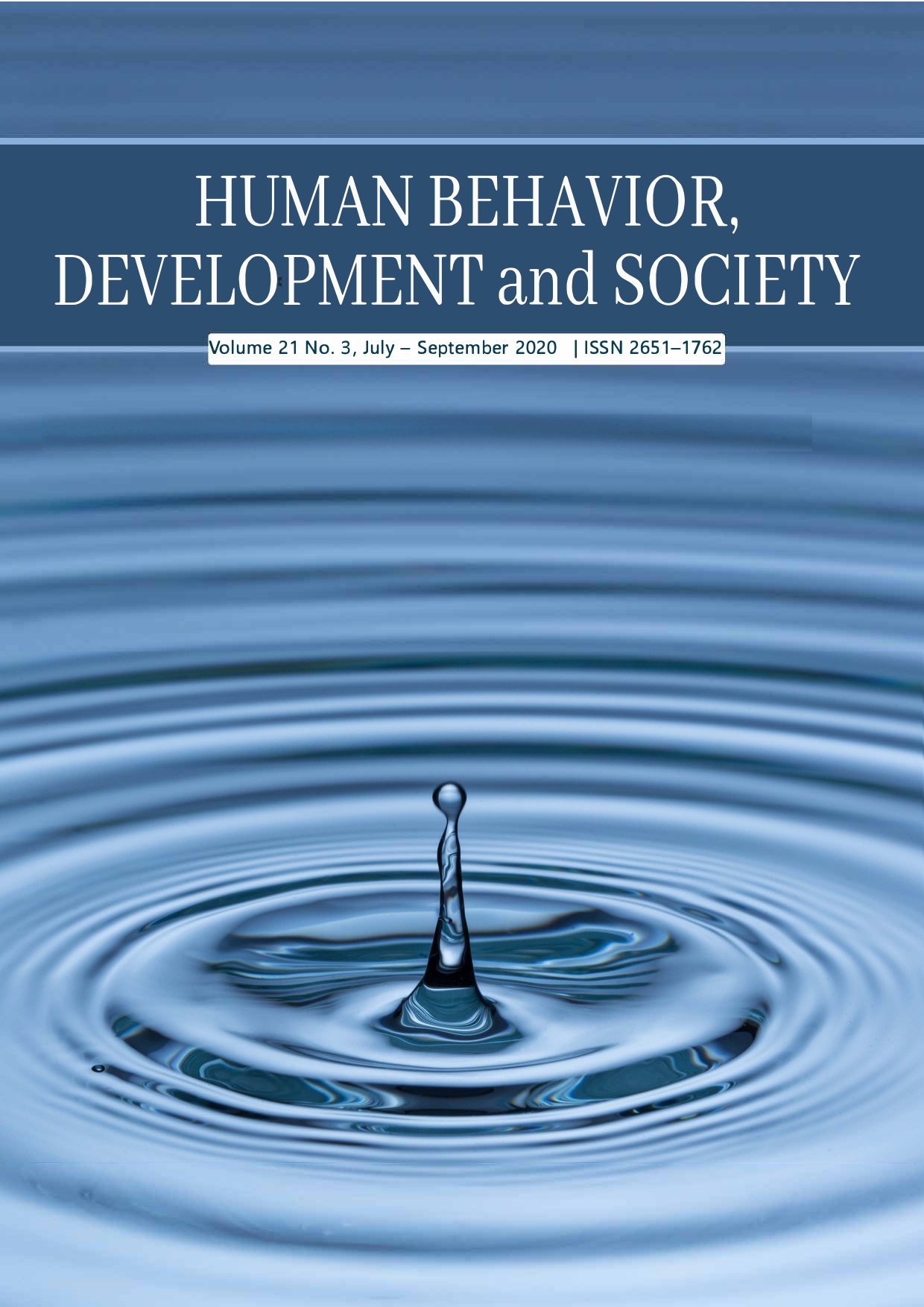Adaptation Strategies of Farmers to Counter the Impact of Violent Incidents in the Three Southern Border Provinces of Thailand
Main Article Content
Abstract
The objective of this research was to explore how violent incidents affected agricultural practices of farmers, how they struggled with these problems, and their methods of adaptation to permit survival. Data were collected from 26 key informants in Narathiwat, Pattani, and Yala Provinces. In-depth interviews and descriptive data analyses were used to indicate farmers’ choice of adaptation strategies. The results indicated that violent incidents affected agricultural activities: some agricultural lands were abandoned, farmer numbers and farm income decreased, agricultural officials and middlemen were prevented from meeting farmers to give advice or buy their products, and investors lacked confidence to make investments. Farmers adapted to these difficulties by adjusting working hours, growing other crops, seeking low-interest loans, using agricultural machinery, hiring elderly local laborers, acquiring knowledge and technology from various online media, along with selling products to local merchants and private investors. The findings of this study can help policymakers to better understand and plan agricultural policies to aid in effective adaptation to violent incidents.
Article Details

This work is licensed under a Creative Commons Attribution-NonCommercial-NoDerivatives 4.0 International License.
Copyright: Asia-Pacific International University reserve exclusive rights to publish, reproduce and distribute the manuscript and all contents therein.
References
Abadie, A., & Gardeazabal, J. (2003). The economic costs of conflict: A case study of the Basque country. American Economic Review, 93(1), 113–132.
Brakman, S., Garretsen, H., & Schramm, M. (2004). The strategic bombing of cities in Germany in World War II and it impact on city growth. Journal of Economic Geography, 4(2), 201–218.
Bui, T., Schreinemachers, P., & Berger, T. (2013). Hydropower development in Vietnam: Involuntary resettlement and factors enabling rehabilitation. Land Use Policy, 31, 536–544.
Bundhuwong, C. (2017). Sētthakit læ kānphatthanā nai phư̄nthī čhangwat chāidǣn phāk tai : kānsamrūat chœ̄ng wiphāk [Economy and development in southern border provinces: A critical investigation]. In A. Unno (Ed.), Nưng thotsawat mānutsayawitthayā læ sangkhomwitthayā kap kānsưksā čhangwat chāidǣn phāk tai [One decade of anthropology and sociology with southern border provinces education] (pp. 31–68). https://socanth.tu.ac.th/ccscs/outreach/media/publication/anusorn-ed-2560/
Bunmak, S. (2013). Remittances: Malay-Thai workers in Malaysia. Parichart Journal, Thaksin University, 26(1), 74–93. https://so05.tcithaijo.org/index.php/parichartjournal/article/view/42944
Caruso, R., & Schneider, F. (2011). The socio-economic determinants of terrorism and political violence in western europe (1994–2007). European Journal of Political Economy, 27(1), 37–49.
Center for Deep South Watch. (2018). Summary of incidents in deep Southern Thailand. https://deepsouthwatch. org/sites/default/files/blogs/attachment/datasheet-032020-en.pdf
Chailap, A., Nissapa, A., & Somboonsuke, B. (2019). Association of macroeconomic indicators with violence incidents in Narathiwat province of southern Thailand-responses for adaptive agricultural management. Proceeding of International Conference on Sustainable Agriculture, Chiangmai, Thailand, 2, 9–22. http://icsa.mcc.cmu.ac.th/proceeding/Proceeding_P09-22-NS05-Apisith%20Chailap.pdf
Chareonwongsak, K. (2012). Sētthasāt wādūai kānkō̜ ʻakānrāI [Economics concerning terrorism]. http://www.kriengsak.com/node/2194
Chitphiromsi, S., Lomlim, C., & Laiphaphon, S. (2012). Sētthasāt kānmư̄ang wādūai kānphatthanā čhangwat chāidǣn phāk tai nai thāmklāng pǣt pī khō̜ng khwām mai sangop [Political economy concerned with the development of southern border provinces during 8 years of insurgency]. https://deepsouthwatch.org/th/ node/2871
Davis, D., & Weinstein, D. (2002). Bones, bombs, and breakpoints: The geography of economic activity. American Economic Review, 92(5), 1269–1289.
Department of Agriculture. (2013). Phatthanā khunnaphāp chīwit chāidǣn tai dūai kasēttrakam [Improve the quality of life on the southern border with agriculture]. Spring Newsletter, 16(10), 2–5.
Frey, B., Luechinger, S., & Stutzer, A. (2007). Calculating tragedy: Assessing the costs of terrorism. Journal of Economic Surveys, 21(1), 1–24.
Freytag, A., Krüger, J., Meierrieks, D., & Schneider, F. (2010). The origins of terrorism: Cross-country estimates on socio-economic determinants of terrorism. European Journal of Political Economy, 27(1), 5–16. http://hdl.handle.net/10419/119352
Ismail, A., & Amjad, S. (2014). Determinants of terrorism in Pakistan: An empirical investigation. Economic Modelling, 37(C), 320–331.
Kitthaworn, P., Lertpipat, D., Poonsap, A., Sainui, S., Daoh, P., Pipitpan, N., Rakdee, O., & Chomaithong, S. (2007). Impact of violence on safety lives and properties: A case study of people migration in three southern provinces of Thailand [Research report, National Research Council of Thailand]. https://soreda.oas.psu. ac.th/show_detail.php?research_id=492
Krieger, T., & Meierrieks, D. (2011). What causes terrorism? Public Choice, 147(1/2), 3–27.
Mahouna, A., Fadina, R., & Barjolle, B. (2018). Farmers’ adaptation strategies to climate change and their implications in the Zou department of south Benin. Environments, 5(15), 2–17. https://doi: org/10.3390/environments5010015
Marohabout, P., Choonpradub, C., & Kuning, M. (2009). Terrorism risk modeling in southern border provinces of Thailand during 2004 to 2005. Songklanakarin Journal Social Sciences and Humanities, 15(6), 885–895. https://soreda.oas.psu.ac.th/show_detail.php?research_id=503
Miguel, E., & Roland, G. (2005). The long run impact of bombing Vietnam. Journal of Development Economics, 96, 1–5. https://doi: org/10.1016/j.jdeveco.2010.07.004
National Statistical Office. (2019). Chamnūan khrūarư̄an kasēttrakō̜n thī khưn thabīan kasēttrakō̜n čhamnǣk rāi čhangwat Phō̜.Sō̜. 2557–2561 [2014–2018 Census of registered agricultural households classified by province]. http://statbbi.nso.go.th/staticreport/page/sector/th/11.aspx
Office of the National Economic and Social Development Board. (2009). Phǣnkān phatthanā phư̄nthī phisēt hā čhangwat chāidǣn phāk tai pī 2552-2555 [Development plan for special areas in the 5 southern border provinces 2009–2012]. http://slbkb.psu.ac.th/xmlui/bitstream/handle/2558/1068/แผนพัฒนาพื้นที่พิเศษ%205%20จังหวัดชายแดนภาคใต้.pdf?sequence=1&isAllowed=y
Sama-air, A., & Mhadmarn, H. (2016). The opinion of community leaders on economic development of government in three southern border provinces. Al-Nur Journal of Graduate School of Fatoni University, 11(20), 151–164. https://so01.tci-thaijo.org/index.php/NUR_YIU/article/view/77808/62388
Sanongphan, S. (2012). The political violence in the three southern border provinces of Thailand. Research Journal of Rajamangala University of Technology Srivichai, 4(2), 31–45. http://rdi.rmutsv.ac.th/rmutsvrj/ download/year4-issue2-2555/p31.pdf
Singh, P. (2012). Insurgency, crime, and agricultural labor expenditure: Evidence from Punjab, 1978–1990. Economics of Peace and Security Journal, 7(2), 33–40.
Songsom, A. (2009). Household economy in Pattani province under the southern unrest. Journal of Humanities and Social Sciences, 5(2),37–70. https://so03.tci-thaijo.org/index.php/eJHUSO/article/view/85872
Thaksin University. (2017). Phǣn phatthanā klum čhangwat phāk tai chāidǣn sī pī ( Phō̜.Sō̜. 2561–2564) [Four-year development plan for southern border provinces (2018–2021)]. https://www.osmsouth-border.go.th/news_develop


